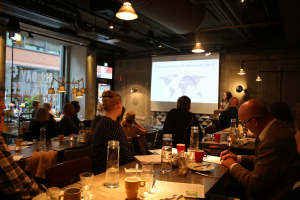June 12, 2019
A dedicated, university-based team that bridges the science-policy divide
Posted by Caitlin Bergstrom
Dr. Michelle McCrackin is a biogeochemist interested in how agriculture, urbanization, energy production, and land use change have influenced nutrient cycling in watersheds, with particular interest in lake and coastal ecosystems. She is a researcher with Baltic Eye in Stockholm, Sweden.
For the past five years, I have been part of a novel team, called Baltic Eye, at Stockholm University’s Baltic Sea Centre. Our team is composed of researchers, communicators (including a journalist) and policy analysts; together, we work to support evidence-based decision-making for the Baltic Sea’s environment.
As a researcher with Baltic Eye, I have benefited both personally and professionally from being part of this interdisciplinary team. I have learned so much from my colleagues and appreciate the different perspectives that they bring to our work. The policy analysts have a diverse network and scan the policy horizon to identify opportunities where we can engage, such as public consultations on proposed legislation or parliamentary committee meetings. The communicators maintain our web magazine, write articles, conduct interviews, and work closely with the team to clarify the messages and achieve the appropriate tone.
Our research focuses on biodiversity and coastal habitats, eutrophication, fish and fisheries management, and hazardous substances. We conduct synthesis and analyses of existing knowledge and large-scale modeling. The Baltic Eye researchers generally do not conduct fieldwork but benefit from being part of the Baltic Sea Centre, which maintains a research station, several research vessels, and collaborations with other universities in the region. Examples of research projects include describing the fate of microplastics in the sea, quantifying possible nutrient load reductions from land by improving agronomic practices, and modeling the fate of PCBs in the environment. Most research projects result in peer-reviewed publications. Researchers, like me, take the lead in scoping the project tasks and timeline and articulating the scientific merit. The policy analysts identify linkages to policy processes and the communicators develop strategies to reach the target audience. Our work is mostly aimed at members of parliament in Sweden and Brussels, civil servants at Swedish and EU ministries (e.g. environment, agriculture, fisheries), and environmental non-profit organizations. For some issues, such as coastal habitats and marine protected areas, our outreach involves municipalities and other local stakeholders in Sweden.
Baltic Eye’s main communication product is the policy brief; a 4-page summary of an issue, the science, and policy recommendations. We work with graphic designers to create eye-catching visuals that illustrate important concepts. Printed policy briefs are distributed at public events and face-to-face meetings. Electronic versions are available for download from our website and are promoted on social media with accompanying articles and short video clips that explain the key messages. We also sponsor monthly “Baltic Breakfasts” at a hotel in central Stockholm. Each breakfast covers a pre-determined topic, such as invasive species, the status of cod fisheries, and how climate change could affect the sea. A continental breakfast is followed by two short presentations by scientists and a Q & A session.
Measuring the impact of Baltic Eye’s work is hard but we believe that we have made a difference. For example, there have been a number of instances when decision-makers used the information that we provided to them in their speeches, by using our materials directly or using the same phrasing that we used. Politicians and decision-makers have also publicly acknowledged and thanked Baltic Eye for providing support and information. Lastly, we see that decision makers reach out to us proactively with questions about the sea’s environment.
Baltic Eye was recently the subject of a peer-reviewed article that explored how a university-based boundary organization could increase knowledge exchange between scientists and society. Team members were interviewed by a social scientist and the results are available through open access.
This article further discusses the challenges and barriers we experienced during our first few years and the key features that are needed in research organizations to enhance the impact of science on policy and practice. Organizations such as Baltic Eye also offer an alternative, non-tenure track, career path for university-based scientists. The article also notes that the Baltic Eye team members find their work be stimulating and educational and that it has led to increased job satisfaction. As one of those team members, I can certainly agree with that!
For more information about Baltic Eye, check out their webpage


